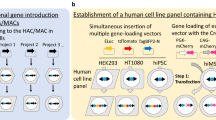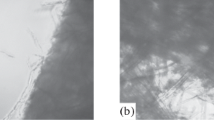Abstract
A method for the production of stable mouse-human cell hybrids containing a single human chromosome is described. As a first step in this method, a cloned selectable marker, the E. coli xanthine-guanine phosphoribosyltransferase (Ecogpt) gene, was transferred to human cells to generate cell lines each carrying Ecogpt integrated into a different site. Human chromosomes marked with Ecogpt were transferred further into mouse cells by microcell fusion. Monochromosomal hybrids, in which the human chromosome is maintained by selection, have been produced for chromosomes 2, 5, 16, and a rearranged chromosome involving a translocation between chromosomes 1 and 2. In addition to these monochromosomal hybrids, we have also obtained monochromosomal hybrids for human chromosomes 6, 12, and 17 by selection for the loss of marked chromosome from the microcell hybrids each containing two human chromosomes. Although the human chromosome present in these hybrids cannot be maintained by selection, 80–90% of cells retained the transferred chromosome on continuous growth for 15 days. Monochromosomal hybrids would provide biological materials to construct genetic maps of human chromosomes. In addition, chromosomes marked with dominant selectable markers can be transferred further to any cell line of interest in inter- or intra-species combination.
Similar content being viewed by others
Literature cited
Ege, T., and Ringertz, N.R. (1974).Exp. Cell Res. 87:378–382.
Fournier, R.E.K., and Ruddle, F.H. (1977).Proc. Natl. Acad. Sci. U.S.A. 74:319–323.
Fournier, R.E.K., and Frelinger, J.A. (1982).Mol. Cell. Biol. 2:526–534.
Athwal, R.S., and Dhar, V. (1984). InGene Transfer and Cancer, (ed.) Pearson, M.L. and Sternberg, N.L. (Raven Press, New York), pp. 21–29.
Dhar, V., Searle, B.M., and Athwal, R.S. (1984).Somat. Cell Mol. Genet. 10:547–559.
McNeill, C.A., and Brown, R.L. (1980).Proc. Natl. Acad. Sci. U.S.A. 77:5394–5398.
Wigler, M., Silverstein, S., Lee, L.S., Pellicer, A., Cheng, Y.C., and Axel, R. (1977).Cell 11:223–232.
McBride, O.W., and Ozer, H.L. (1973).Proc. Natl. Acad. Sci. U.S.A. 70:1258–1262.
Fournier, R.E.K., and Ruddle, F.H. (1977).Proc. Natl. Acad. Sci. U.S.A. 74:3937–3941.
Klobutcher, L.A., and Ruddle, F.H. (1979).Nature 280:657–660.
Robins, D.M., Ripley, S., Henderson, A.S., and Axel, R. (1981).Cell 23:29–39.
Donner, L., Dubbs, D.R., and Kit, S. (1977).Int. J. Cancer 20:256–267.
McKinlay, M.A., Wilson, D.E., Harrison, B., and Povey, S. (1980).J. Natl. Cancer Inst. 64:241–248.
Smiley, J.R., Steege, D.A., Juricek, D.K., Summers, W.P., and Ruddle, F.H. (1978).Cell 15:455–468.
Tunnacliffe, A., Parker, M., Povey, S., Bengtsson, B.O., Stanley, K., Solomon, E., and Goodfellow, P. (1983).Embo J. 2:1577–1584.
Mulligan, R.C., and Berg, P. (1981).Proc. Natl. Acad. Sci. U.S.A. 78:2072–2076.
Southern, P.J., and Berg, P. (1982).J. Mol. Appl. Genet. 1:327–341.
O'Hare, K., Benoist, C., and Breathnach, R. (1981).Proc. Natl. Acad. Sci. U.S.A. 78:1527–1531.
Kushner, S.R. (1978). InGenetic Engineering, (eds.) Boyer, H.B., and Nicosia, S. (Elsevier-North Holland, Amsterdam), p. 17.
Birnboim, H.C., and Doly, J. (1979).Nucleic Acid Res. 7:1513–1523.
Southern, E.M. (1975).J. Mol. Biol. 98:503–517.
Alwine, J.C., Kemp, D.J., Parker, B.A., Reiser, J., Renart, J., Stark, G.R., and Wahl, G.M. (1979).Methods Enzymol. 68:220–242.
Rigby, P.W.J., Dieckmann, M., Rhodes, C., and Berg, P. (1977).J. Mol. Biol. 113:237–251.
Fournier, R.E.K. (1981).Proc. Natl. Acad. Sci. U.S.A. 78:6349–6353.
Peterson, E.A., and Evans, W.H. (1967).Nature 214:824–826.
Mercer, W.E., and Schlegal, R.A. (1979).Exp. Cell Res. 120:417–421.
Bobrow, M., and Gross, J. (1974).Nature 251:77–79.
Seabright, M. (1971).Lancet 2:971–972.
Harris, H., and Hopkinson, D.A. (1976).Handbook of Enzyme Electrophoresis in Human Genetics, (Elsevier, New York).
Bakay, B., and Nyhan, W.L. (1971).Biochem. Genet. 5:81–90.
Gusella, J.F., Jones, C., Kao, F.T., Housman, D., and Puck, T.T. (1982).Proc. Natl. Acad. Sci. U.S.A. 79:7804–7808.
Goss, S., and Harris, H. (1977).J. Cell Sci. 25:17–37.
Law, M.L., and Kao, F.T. (1979).Cytogenet. Cell Genet. 24:102–114.
Danna, S., and Wasmuth, J.J. (1982).Mol. Cell. Biol. 2:1220–1228.
Goss, S.I., and Harris, H. (1977).J. Cell Sci. 25:39–57.
Burgerhout, W.G., Leupe-DeSmit, S., and Jongsma, A.P.M. (1977).Cytogenet. Cell Genet. 18:267–283.
Author information
Authors and Affiliations
Rights and permissions
About this article
Cite this article
Athwal, R.S., Smarsh, M., Searle, B.M. et al. Integration of a dominant selectable marker into human chromosomes and transfer of marked chromosomes to mouse cells by microcell fusion. Somat Cell Mol Genet 11, 177–187 (1985). https://doi.org/10.1007/BF01534706
Received:
Revised:
Issue Date:
DOI: https://doi.org/10.1007/BF01534706




